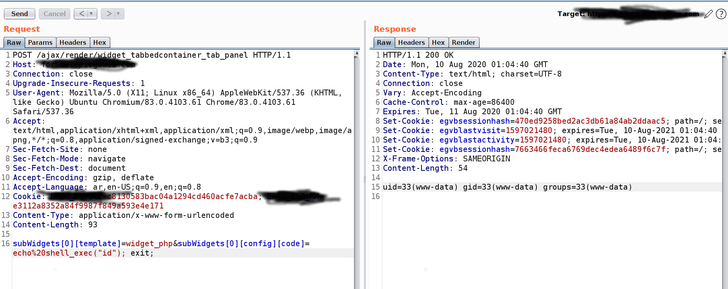
A New vBulletin 0-Day RCE Vulnerability and Exploit Disclosed Publicly
9.8 High
CVSS3
Attack Vector
NETWORK
Attack Complexity
LOW
Privileges Required
NONE
User Interaction
NONE
Scope
UNCHANGED
Confidentiality Impact
HIGH
Integrity Impact
HIGH
Availability Impact
HIGH
CVSS:3.1/AV:N/AC:L/PR:N/UI:N/S:U/C:H/I:H/A:H
7.5 High
CVSS2
Access Vector
NETWORK
Access Complexity
LOW
Authentication
NONE
Confidentiality Impact
PARTIAL
Integrity Impact
PARTIAL
Availability Impact
PARTIAL
AV:N/AC:L/Au:N/C:P/I:P/A:P
A security researcher earlier today publicly revealed details and proof-of-concept exploit code for an unpatched, critical zero-day remote code execution vulnerability affecting the widely used internet forum software vBulletin that’s already under active exploitation in the wild.
vBulletin is a widely used proprietary Internet forum software package based on PHP and MySQL database server that powers over 100,000 websites on the Internet, including Fortune 500 and Alexa Top 1 million companies websites and forums.
In September last year, a separate anonymous security researcher publicly disclosed a then-zero-day RCE vulnerability in vBulletin, identified as CVE-2019-16759, and received a critical severity rating of 9.8, allowing attackers to execute malicious commands on the remote server without requiring any authentication to log into the forum.
A day after the disclosure of CVE-2019-16759, the vBulletin team released security patches that resolved the issue, but it turns out that the patch was insufficient in blocking the exploitation of the flaw.
Bypassing the Patch for the CVE-2019-16759 RCE Flaw
The newly released zero-day, discovered, and publicly published by security researcher Amir Etemadieh (Zenofex), is a bypass for CVE-2019-16759. The flaw did not receive any CVE identifier at the time this blog post was published.
The latest zero-day vulnerability should be viewed as a severe issue because it is remotely exploitable and doesn’t require authentication. It can easily be exploited using an exploit code of a single one-line command that can result in remote code execution in the latest vBulletin software.
According to the researcher, the patch for CVE-2019-16759 did not resolve the issues present in the “widget_tabbedcontainer_tab_panel” template, i.e., its ability to load a user-controlled child template and to load the child template, it takes a value from a separately named value and places it into a variable named “widgetConfig,” effectively allowing the researcher to bypass the patch for CVE-2019-16759.
The researcher also published three proofs-of-concept exploit payloads written in multiple languages, including Bash, Python, and Ruby.
Hackers Actively Exploiting vBulletin Zero-Day
Soon after the release of the PoC exploit code, hackers started exploiting the zero-day to target vBulletin sites.
According to DefCon and Black Hat security conferences creator Jeff Moss, the DefCon forum was also attacked with the exploit just 3 hours after the flaw was disclosed.
“A new VBulletin Zero Day got dropped yesterday by @Zenofex that revealed the CVE-2019-16759 patch was incomplete - within three hours https://forum.defcon.org was attacked, but we were ready for it. Disable PHP rendering to protect yourself until patched!,” said Moss.
Official vBulletin Patch and Mitigations
The vBulletin team responded to the publicly released zero-day flaw immediately and released a new security patch that disables the PHP module in vBulletin software to address the issue, assuring its users that it will be removed entirely in the future release of vBulletin 5.6.4.
The forum maintainers advised developers to consider all older versions of vBulletin vulnerable and upgrade their sites to run vBulletin 5.6.2 as soon as possible. Developers can check Quick Overview: Upgrading vBulletin Connect in the support forums for more information on upgrading.
Though The Hacker News strongly advise users and developers to upgrade their forums to the new vBulletin version, those who can not update immediately can mitigate the new zero-day by disabling PHP widgets within your forums, to do this:
- Go to the vBulletin administrator control panel and click “Settings” in the menu on the left, then “Options” in the dropdown.
- Choose “General Settings” and then click “Edit Settings.”
- Look for “Disable PHP, Static HTML, and Ad Module rendering,” Set to “Yes.”
- Click “Save”
Note that these changes could break some functionality but will mitigate the issue until you plan to apply the official security patches.
Found this article interesting? Follow THN on Facebook, Twitter and LinkedIn to read more exclusive content we post.
9.8 High
CVSS3
Attack Vector
NETWORK
Attack Complexity
LOW
Privileges Required
NONE
User Interaction
NONE
Scope
UNCHANGED
Confidentiality Impact
HIGH
Integrity Impact
HIGH
Availability Impact
HIGH
CVSS:3.1/AV:N/AC:L/PR:N/UI:N/S:U/C:H/I:H/A:H
7.5 High
CVSS2
Access Vector
NETWORK
Access Complexity
LOW
Authentication
NONE
Confidentiality Impact
PARTIAL
Integrity Impact
PARTIAL
Availability Impact
PARTIAL
AV:N/AC:L/Au:N/C:P/I:P/A:P

